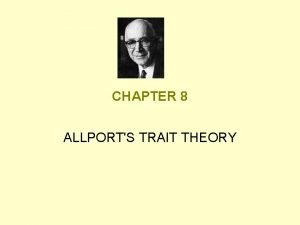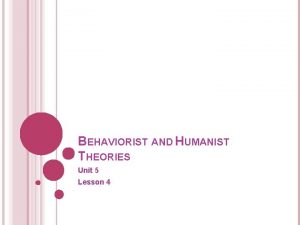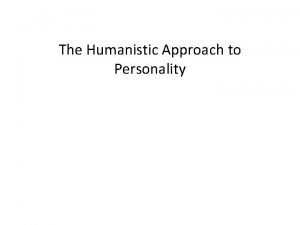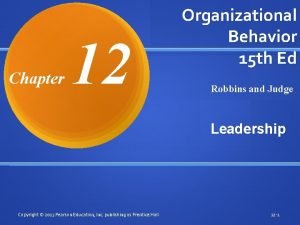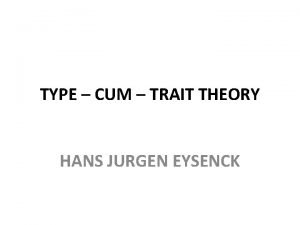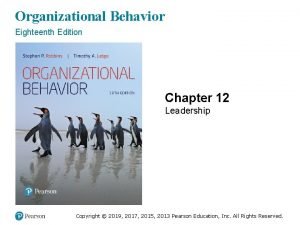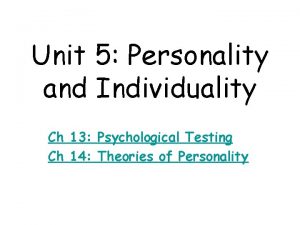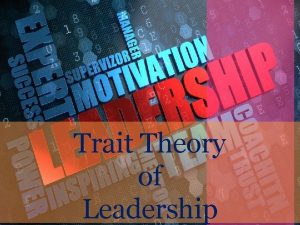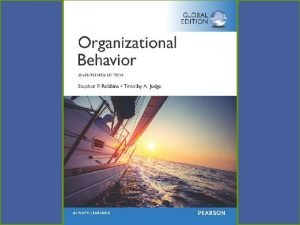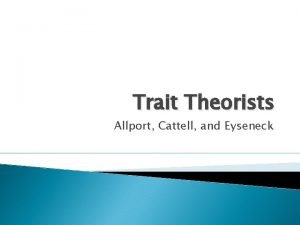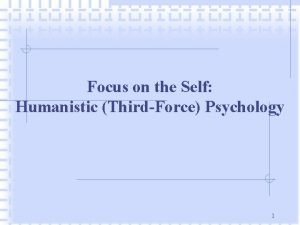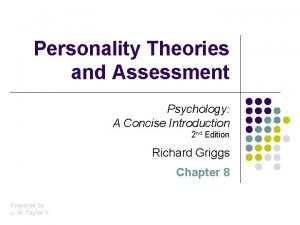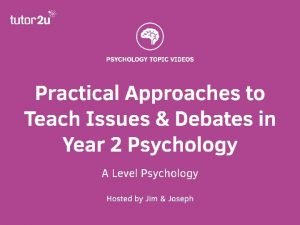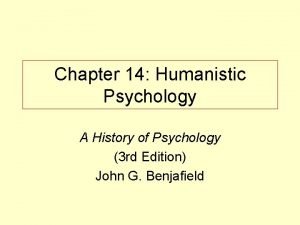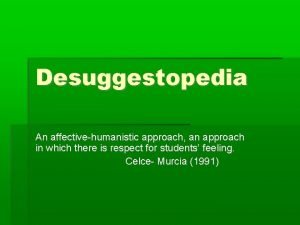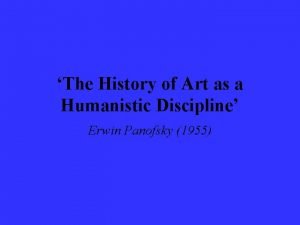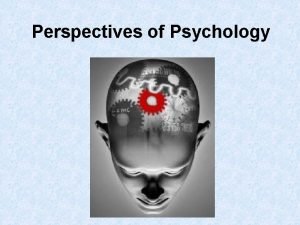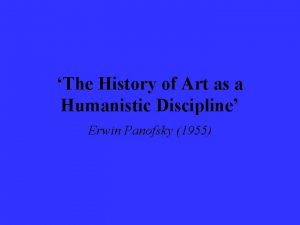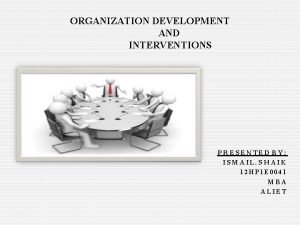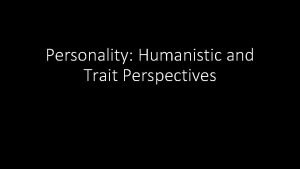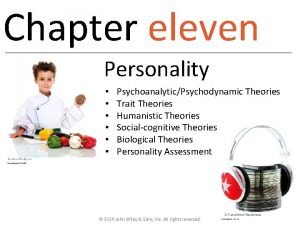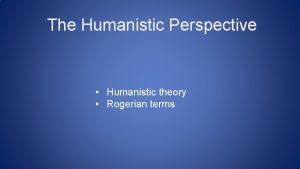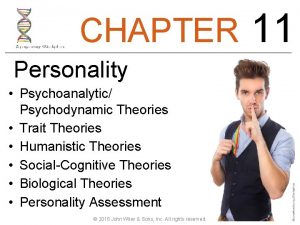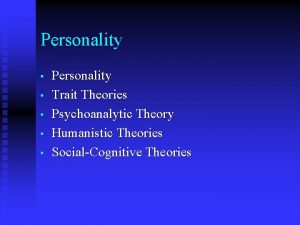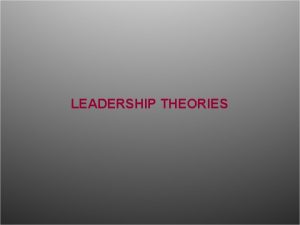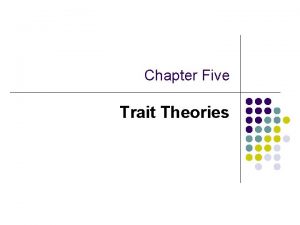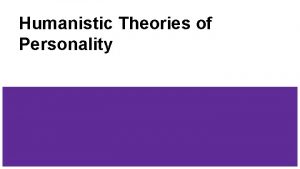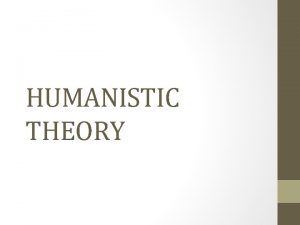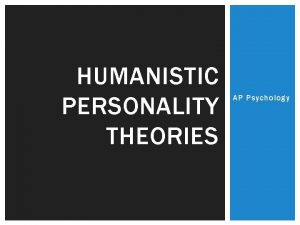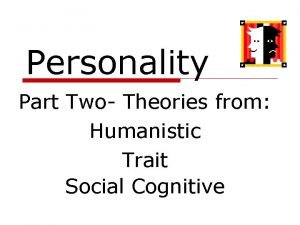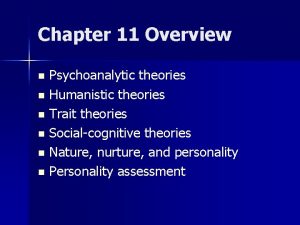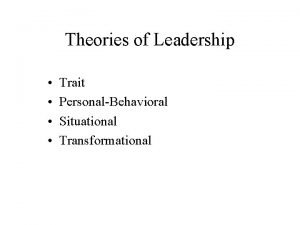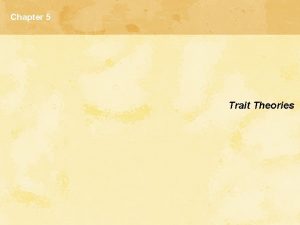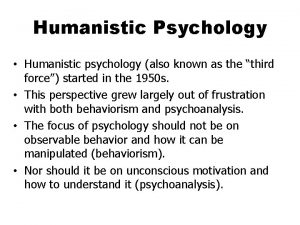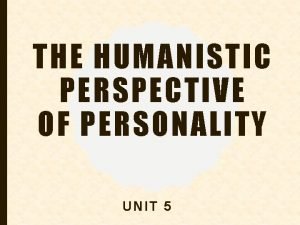Lecture Overview Trait Theories PsychoanalyticPsychodynamic Theories Humanistic Theories































- Slides: 31

Lecture Overview • • • Trait Theories Psychoanalytic/Psychodynamic Theories Humanistic Theories Social-Cognitive Theories Biological Theories Personality Assessment ©John Wiley & Sons, Inc. 2010

Key Definition • Personality: unique & relatively stable pattern of thoughts, feelings, & actions ©John Wiley & Sons, Inc. 2010

Trait Theories • Trait: relatively stable personal characteristic used to describe someone • Key Figures: – Early Trait Theorists: Allport, Cattell, Eysenck – Modern Trait Theorists: Mc. Crae & Costa-Five-Factor Model (FFM) ©John Wiley & Sons, Inc. 2010

Five Factor Model • • • Openness Conscientiousness Extroversion Agreeableness Neuroticism OCEAN ©John Wiley & Sons, Inc. 2010

Pause & Reflect: Psychology at Work Measuring Personality Traits Goes both ways! Conscientiousness can reflect a hard-working person or someone with OCD. ©John Wiley & Sons, Inc. 2010

Evaluating Trait Theories • Pro: – Five-factor model (FFM) helps describe & organize personality characteristics using the fewest number of traits. – Evolutionary, cross-cultural, & cross-species studies support five-factor model (FFM). • Con: • Dan Mc. Adams: “The Psychology of a Stranger” – Lacks explanation – Ignores situational effects; doesn’t predict behavior ©John Wiley & Sons, Inc. 2010

Psychoanalytic/Psychodynamic Theories • Psychoanalytic/Psychodynamic Theories: examine how unconscious mental forces interplay with thoughts, feelings, & actions. Accounts for inner conflict • Early Key Figures: – Founding Father--Freud – Neo-Freudians--Adler, Jung, Horney ©John Wiley & Sons, Inc. 2010

Psychoanalytic/Psychodynamic Theories: Levels of Consciousness • Conscious: thoughts or motives person is currently aware of or remembering • Preconscious: thoughts, motives, or memories that can be voluntarily brought to mind • Unconscious: thoughts, motives, or memories blocked from normal awareness ©John Wiley & Sons, Inc. 2010

Psychoanalytic/Psychodynamic Theories: Personality Structures • Id: instinctual energy (pleasure principle) • Ego: rational part of psyche (reality principle) • Superego: the conscience (morality principle) ©John Wiley & Sons, Inc. 2010

Psychoanalytic/Psychodynamic Theories: Defense Mechanisms • Defense mechanisms: ego’s protective method of reducing anxiety by distorting reality EGO ID ©John Wiley & Sons, Inc. 2010 SUPER EGO

©John Wiley & Sons, Inc. 2010

Psychoanalytic/Psychodynamic Theories: Psychosexual Stages of Development • Psychosexual Stages: Freudian idea of five developmental periods key to personality development – Oral Stage: birth-18 months – Anal Stage: 18 months-3 yrs – Phallic Stage: 3 -6 yrs – Latency Stage: 6 yrs-puberty – Genital Stage: puberty-adulthood ©John Wiley & Sons, Inc. 2010

• Freud believed all children pass through five psychosexual stages. At each stage the id’s pleasure seeking energies focus on specific pleasure areas of the body (erogenous zones). ©John Wiley & Sons, Inc. 2010

Psychoanalytic/Psychodynamic Theories: Neo-Freudian Theorists • Adler: suggested that most people experience an inferiority complex, which later results in a “will-topower” that can be either positive or negative ©John Wiley & Sons, Inc. 2010

Psychoanalytic/Psychodynamic Theories: Neo-Freudian Theorists • Jung: proposed an inherited collective unconscious consisting of archetypes ©John Wiley & Sons, Inc. 2010

Psychoanalytic/Psychodynamic Theories: Neo-Freudian Theorists • Horney: believed some adults experience basic anxiety due to childhood feelings of helplessness and isolation ©John Wiley & Sons, Inc. 2010

Evaluation? • Pro: • Con: – Emphasis on unconscious, – Difficult to test intra-psychic conflicts – Overemphasizes drive reduction & unconscious – Modern psychodynamic theories have moved away forces from psychosexual analysis – Inadequate evidence for theory and focus on relationships – Sexism “Object Relations” ©John Wiley & Sons, Inc. 2010

Personality Development: Erikson’s Eight Psychosocial Stages • Erikson identified 8 psychosocial stages of development—each marked by a “psychosocial” crisis or conflict related to a specific developmental task. ©John Wiley & Sons, Inc. 2010

Humanists • Emphasis: – Personality develops from internal experiences (feelings & thoughts) & individual feelings of basic worth. – People are innately good (or, at worst, neutral) with a positive drive toward self-fulfillment. • Key Figures: Rogers & Maslow ©John Wiley & Sons, Inc. 2010

Humanistic Theories: • Key component of personality = the self, what a person defines as “I” or “me” • Mental health is related to the degree of congruence between the self-concept & life experiences. ©John Wiley & Sons, Inc. 2010 cepts

Humanistic Theories: Rogers’s Key Terms (Continued) • Unconditional Positive Regard: love & acceptance with no contingencies attached ©John Wiley & Sons, Inc. 2010

Humanistic Theories: Maslow’s Hierarchy of Needs • Hierarchy of Needs: Maslow’s proposal that basic physical necessities must be satisfied before higher-growth needs • Self-Actualization: Maslow’s term for the inborn drive to develop all one’s talents & capabilities ©John Wiley & Sons, Inc. 2010

Evaluating Humanistic Theories • Pro: – Many concepts incorporated into successful therapy • Con: – Naive assumptions – Poor testability & inadequate evidence – Narrowness ©John Wiley & Sons, Inc. 2010

Social-Cognitive Theories • Social Cognitive Theories Personality reflects: – individual’s interactions environment – how people think about world & interpret to them – Key Figures: Rotter ©John Wiley & Sons, Inc. 2010 with the what happens Bandura &

Social-Cognitive Theories: Bandura’s Key Terms • Self-Efficacy: person’s learned expectation of success • Reciprocal Determinism: cognitions, behaviors, & the environment interact to produce personality ©John Wiley & Sons, Inc. 2010

Social-Cognitive Theories: Rotter’s Key Terms • Cognitive Expectancies: what people expect to happen • Reinforcement Value: degree to which people prefer one reinforcer over another • Locus of Control: what people consider the source of life’s rewards & punishments (internal or external locus of control) ©John Wiley & Sons, Inc. 2010

Evaluating Social-Cognitive Theories • Pro: • Con: – Emphasizes how – Narrow focus environment affects – Ignores & is affected by unconscious & individuals emotional aspects – Easy to measure in of personality psychology experiments ©John Wiley & Sons, Inc. 2010

Biology • Three major biological contributors to personality: • Brain Structures • Neurochemistry • Genetic Factors ©John Wiley & Sons, Inc. 2010

Integrating the Perspectives • Biopsychosocial model suggests multiple theories provide different insights & contribute different proportions to personality. ©John Wiley & Sons, Inc. 2010

Personality Assessment • • • Four methods to measure personality: Interviews Observations Objective Tests (MMPI) Projective Tests (Rorschach, TAT) ©John Wiley & Sons, Inc. 2010

Two Key Criteria for Test Assessment • Reliability: Measure of the consistency & reproducibility of a test’s scores when test is given again • Validity: Ability of a test to measure what it was designed measure ©John Wiley & Sons, Inc. 2010
 Difference between humanistic and trait theory
Difference between humanistic and trait theory Humanistic traits
Humanistic traits Humanist vs behaviorist
Humanist vs behaviorist Maslow humanistic theory of personality
Maslow humanistic theory of personality Trait theory
Trait theory Theory of learning by insight
Theory of learning by insight 01:640:244 lecture notes - lecture 15: plat, idah, farad
01:640:244 lecture notes - lecture 15: plat, idah, farad Summarize the conclusions of trait theories of leadership
Summarize the conclusions of trait theories of leadership Module 58 trait theories
Module 58 trait theories Trait theory of personality
Trait theory of personality Organizational behavior chapter 12
Organizational behavior chapter 12 Trait theories of personality _____.
Trait theories of personality _____. Social development theory
Social development theory Traits theory of leadership
Traits theory of leadership Summarize the conclusions of trait theories of leadership.
Summarize the conclusions of trait theories of leadership. Trait theorists are more concerned with
Trait theorists are more concerned with Chapter 7 motivation concepts
Chapter 7 motivation concepts Abraham maslow psychology definition
Abraham maslow psychology definition Freud personality theory
Freud personality theory Humanistic approach tutor2u
Humanistic approach tutor2u When was humanistic psychology founded
When was humanistic psychology founded What is desuggestopedia method
What is desuggestopedia method Harry maslow
Harry maslow Was maslow a humanistic psychologist
Was maslow a humanistic psychologist Humanistic research
Humanistic research Humanistic discipline
Humanistic discipline Andrea yates humanistic perspective
Andrea yates humanistic perspective Art as humanistic discipline
Art as humanistic discipline Dr barbara combines techniques from humanistic
Dr barbara combines techniques from humanistic Humanistic values of organizational development
Humanistic values of organizational development Humanistic-existential perspective
Humanistic-existential perspective Humanistic perspective
Humanistic perspective
